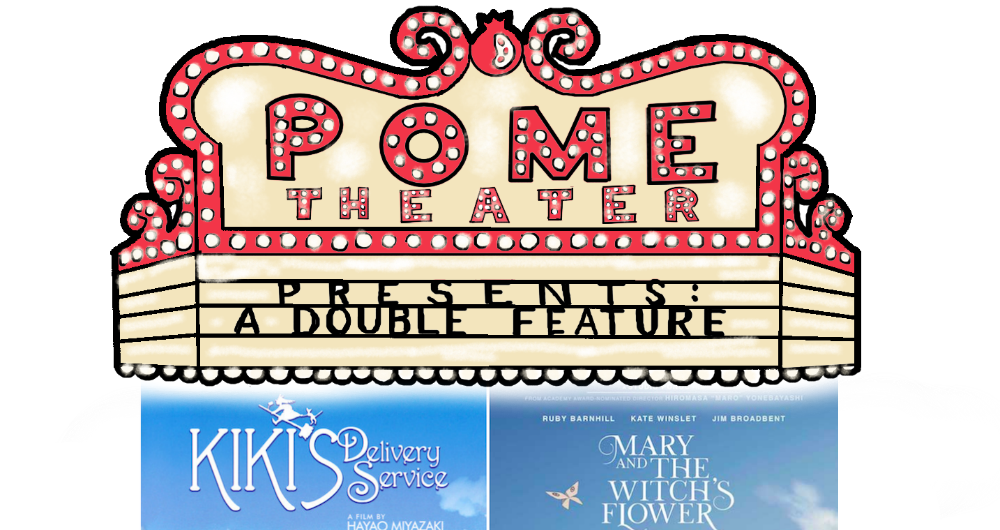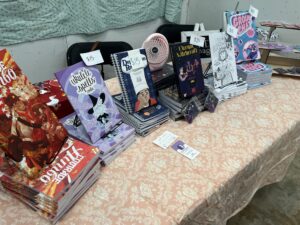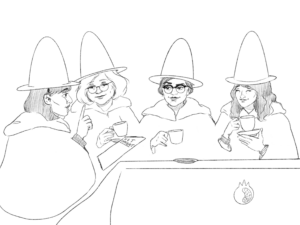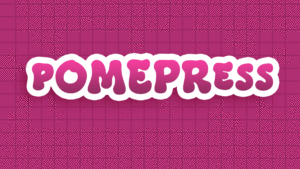I love nothing more than a good, old-fashioned, Girl Comes of Age through Witchcraft story — it is far and away my favorite genre of anything ever. As we’ve discussed in previous Double Features, witchcraft is one of the clearest and most popular metaphorical devices for women exerting independence, and it’s all the more powerful when applied to a young girl’s journey towards self-discovery. With that in mind, I present to you, the reader, this beautiful and perfect double feature.
This week:
Kiki’s Delivery Service — Mary and the Witch’s Flower
Kiki’s Delivery Service:
For the uninitiated, Kiki’s Delivery Service (1989) is the fun and heartwarming story of a young witch struggling with depression during her first year away from home.
According to witch custom, when you turn 13, it’s time to go away for a year — to experience the world and also to begin your training/hone your Skill (these skills are about what you would expect; Kiki’s skill is flying, but other skills include: potions, fortune telling, etc.).
Kiki begins her journey full of hope and excitement. Everything is an adventure to her — from deciding on a city, to finding a place to stay, to learning to make food for herself. She meets good and kind people, and she starts her own Delivery Service business. Things are going well until, gradually, and for no one reason in particular, she loses heart.
Because she is a witch, Kiki’s depression manifests as a loss of her magic powers — she can no longer communicate with her cat familiar, and she finds herself unable to fly (which means she is unable to operate her flying delivery business, unable to support herself in this capitalist hell we call the world). But, she finds comfort in the emotional support given to her by the good and kind people in her life.
With some guidance, Kiki finds that, for her, the trick to feeling better is to stop pressuring herself to feel better. She takes time for herself, and for the person she is outside of her powers. She discovers that she has more to offer than just being a witch, and that the people who care about her like her for who she is, rather than for what she can give them (take that, capitalist hell!).
But don’t worry, this isn’t some I Married a Witch starring Veronica Lake malarkey — Kiki doesn’t lose her powers forever because she felt human emotion. In fact, when one of her new friends is in trouble, she manages to tap back into the part of herself that had been suppressed by her depression in order to fly to his rescue.
This high-stakes rescue is a thrilling action sequence, but it is ultimately just a mechanism by which she is able to complete her emotional journey. The driving force behind this movie’s narrative arc is really Kiki’s search to understand herself and her emotions; and inherent to that goal is a tonal focus on interiority, which can be found even from the very first scene.
This movie opens with a dialogue-free, scenic montage of Kiki cloud-watching in a field by a lake, and then walking back to her house. It is far and away the chillest opening sequence to anything ever, and it sets the tone for the rest of the movie. This is a slow and beautiful film that values self-discovery and emotional growth far above any more traditional driving narrative action.
Kiki’s Delivery Service is the perfect rainy-day movie, the perfect sunny-day movie, the perfect any-day movie. It’s the first movie I ever saw where the witch was a sympathetic protagonist; it’s a complex and heartwarming story about support structures and self-care, about letting yourself rely on others, and about letting others rely on you.
Mary and the Witch’s Flower:
Kiki’s Delivery Service (1989) made me the person I am today, and Mary and the Witch’s Flower (2017) is a natural and long-awaited next step in that legacy.
When Hayao Miyazaki retired in 2014, some of the Studio Ghibli production staff founded a new studio, called Studio Ponoc. And last year, they released Mary and the Witch’s Flower (now showing in select theaters around the country; Regal Gateway 16, for you locals).
Mary and the Witch’s Flower is the story of a young girl who moves to the English countryside, where she discovers a special flower that gives her the power of a witch for one night. With the flower’s magic flowing through her, Mary finds a broomstick that takes her to Endor College, an all-ages school of magic, where she is hailed as a prodigy for her red hair (which she hates) and her powerful magic (which came from the flower, not from within herself). Mary is flattered, and that lowers her guard to the dangers around her — namely, Endor College’s strong research department with murky ethics; they’d do anything to get their hands on the flower. [Spoilers incoming, but hopefully not too many.]
The headmistress of Endor College kidnaps Peter, a boy with whom Mary has struck up a kind of friendship, and ransoms him for Mary’s delivery of the flower. However, when Mary presents the flower, she learns that the headmistress never planned to release either of them, but rather plans to use the both of them for human testing.
So, Mary and Peter must escape, must save the other animals who had been victims of this unethical experimentation, and must keep the flower away from those who would be consumed by its power. Ultimately, all that remains of the flower is used up or destroyed, and Mary must save the day without it. Like Kiki, Mary discovers that she has more to offer than just being a witch, and that the power to save those she cares for was within her all along.
As a slight aside, there’s an interesting connection drawn here between magic and science, and the motivations behind each. In Mary and the Witch’s Flower, magic and science are shown to be two sides of the same coin. Everyone at Endor College is consumed by a thirst for knowledge. No one there, devoting all their time and energy to researching magic, thinks that what they’re doing is wrong, but rather that failed experimentation has as much (if not more) to teach a good scientist as successful experiments; and aren’t they good scientists, just trying to learn something that will benefit the world at large?
There’s a focus on equanimity when dealing with these characters — an effort to stay away from over-simplifying anyone into objectively good or objectively evil, but rather to say that everybody is a complex mixture of both. Good and evil, like magic and science, are treated as two halves of a whole.
But, all of this to say, Mary and the Witch’s Flower is heavily plot-driven — it’s practically step-for-step a Campbellian hero’s journey, with travel between worlds and the achievement of god-like power and the eventual return home, having experienced some growth or change. And that action-centric tone is set right off the bat, in the opening scene.
From the very first, the audience is thrust into action. This in-medias-res style of storytelling is pretty common nowadays — rather than starting at the beginning, this narrative choice is meant to grab the audience’s interest and get them invested in figuring out how the story will come back to this opening action. This narrative decision can sometimes come off as a little gimmicky, but really it’s just representative of a different kind of story, with different objectives and values. Oftentimes, these are stories based on the idea that actions speak louder than words, and that the audience can learn more about a character from the actions they take in response to a situation than from how they articulate their feelings.
Hand in hand with being so action-based, the plot of Mary and the Witch’s Flower is considerably more straightforward, with relatively well-defined goals and motivations — save Peter, free the animals, stop the bad guys. It is still a story about coming to love and accept oneself, but that conclusion is more a byproduct of the narrative, rather than the focus of it.
Where Kiki’s acceptance of herself is followed by narrative action (her renewed ability to fly, and thereby save her friend), Mary’s acceptance of herself comes in the wake of her heroism — Mary proves to herself that she is capable of great things, and that is when she finds happiness and contentment within her.
It’s easy to value one of these stories above the other, or to point to some kind of generational division putting more emphasis on one or the other moral. But, when you get right down to it, these are both beautiful stories about loving communities and self-acceptance. They’re sister films — raised with the same values, but each with their own distinct perspectives.
















